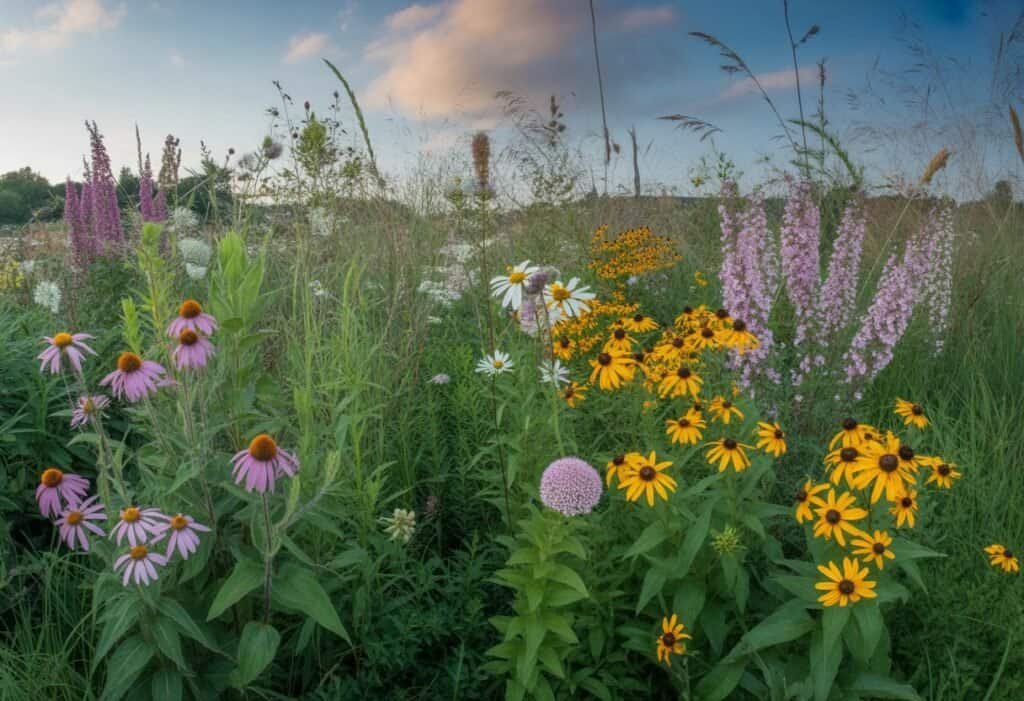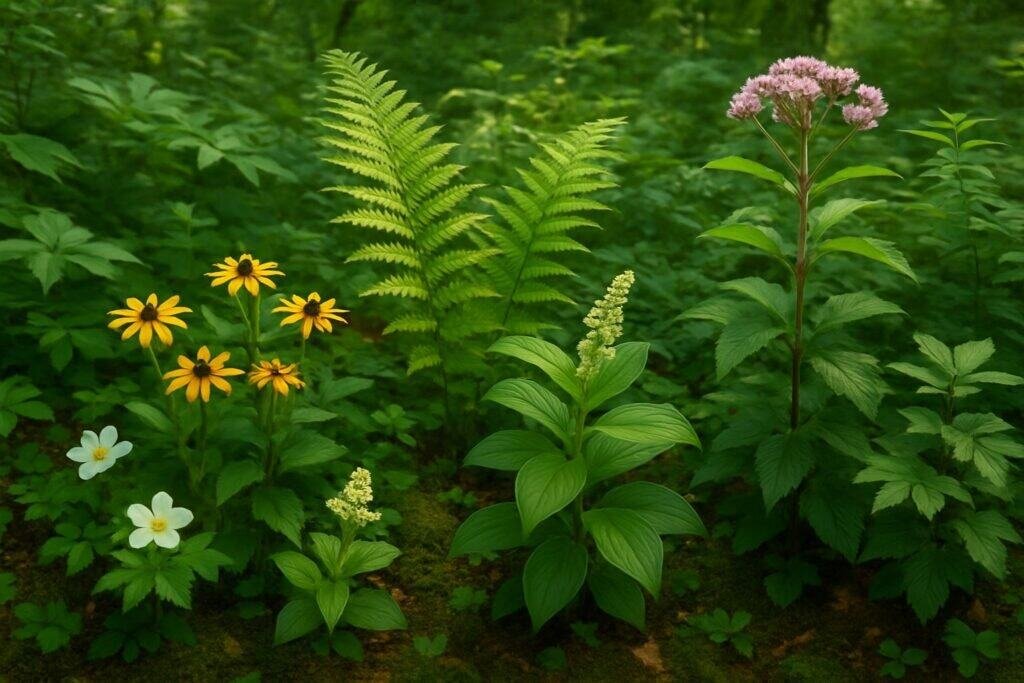Delaware native plants make a wonderful addition to any garden in the First State. These plants have evolved in our local soils and climate for thousands of years.
They thrive with minimal care. Growing native plants helps support local ecosystems, providing food and habitat for birds, butterflies, and beneficial insects.
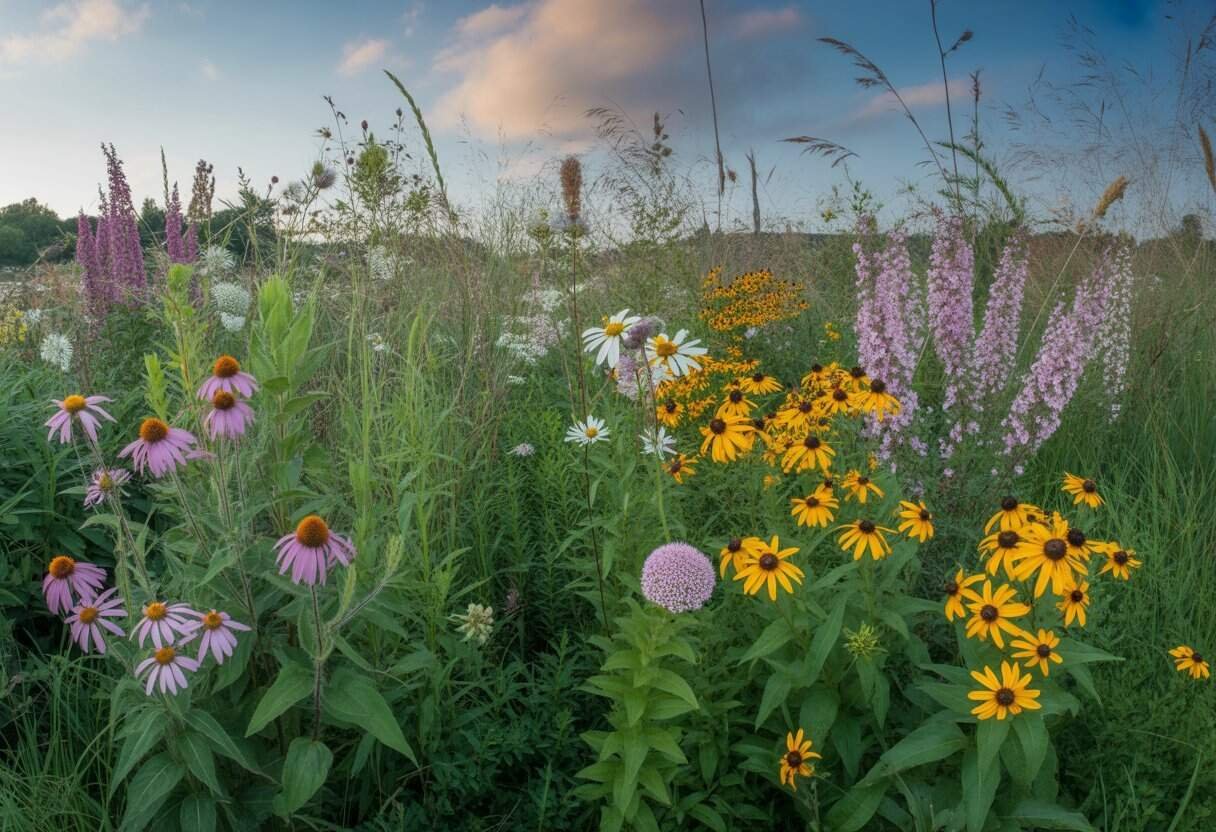
Native plants come in all shapes and sizes, from wildflowers like Black-eyed Susans to trees such as the American Beech. They need less water, fertilizer, and maintenance than non-native species once established.
This makes them environmentally friendly and cost-effective for Delaware gardeners.
Key Takeaways
- Delaware native plants require less maintenance and resources while thriving in local conditions.
- Native plant gardens support local wildlife including pollinators, birds, and beneficial insects.
- Various native options exist for every garden need, from colorful perennials to shade-providing trees.
What Are Delaware Native Plants?
Delaware native plants have grown naturally in the state’s ecosystems for thousands of years. These plants developed special relationships with local wildlife and soil conditions.
Definition and Characteristics
Native plants are species that evolved naturally in a specific region without human introduction. In Delaware, these plants developed over thousands of years in the state’s unique climate and soil.
They include trees like American Beech and White Oak, shrubs such as Highbush Blueberry, and wildflowers like Black-eyed Susan. Delaware native plants typically grow in distinct natural communities.
These communities include coastal dunes, salt marshes, freshwater wetlands, meadows, and forests. Each native plant species has adapted to thrive in specific Delaware habitats.
Swamp Milkweed grows in wet areas, while Wild Columbine prefers partial shade in woodland edges. Delaware natives don’t need special fertilizers, pesticides, or excessive watering once established.
Importance to Local Ecosystems
Native plants form the foundation of Delaware’s food webs. They provide essential nutrition for native insects, which then feed birds and other wildlife.
For example, native Oak trees support over 500 species of caterpillars that become food for birds. These plants offer crucial habitat benefits.
They provide shelter, nesting materials, and safe spaces for wildlife to raise young. Delaware native plants help maintain healthy soil.
Their deep root systems prevent erosion and absorb stormwater, reducing flooding and pollution in waterways. Many native plants have co-evolved with specific pollinators.
Milkweed and Monarch butterflies show this special connection—Monarchs depend entirely on Milkweed to complete their life cycle.
Native Plant Adaptations
Delaware native plants have developed impressive adaptations to local conditions. These adaptations include drought tolerance, pest resistance, and the ability to withstand seasonal temperature changes.
Many native plants feature deep root systems that access groundwater during dry periods. These roots can extend several feet underground, deeper than many non-native ornamental plants.
Native plants have natural defenses against local pests and diseases. These defenses include bitter compounds, sticky resins, or tough leaf surfaces.
Some Delaware natives show remarkable seasonal timing. They coordinate their flowering, fruiting, and seed dispersal with local wildlife needs and weather patterns.
Salt tolerance is another important adaptation for coastal Delaware natives. Plants like Seaside Goldenrod and American Beach Grass thrive in sandy, salty environments.
Benefits of Growing Native Plants in Delaware
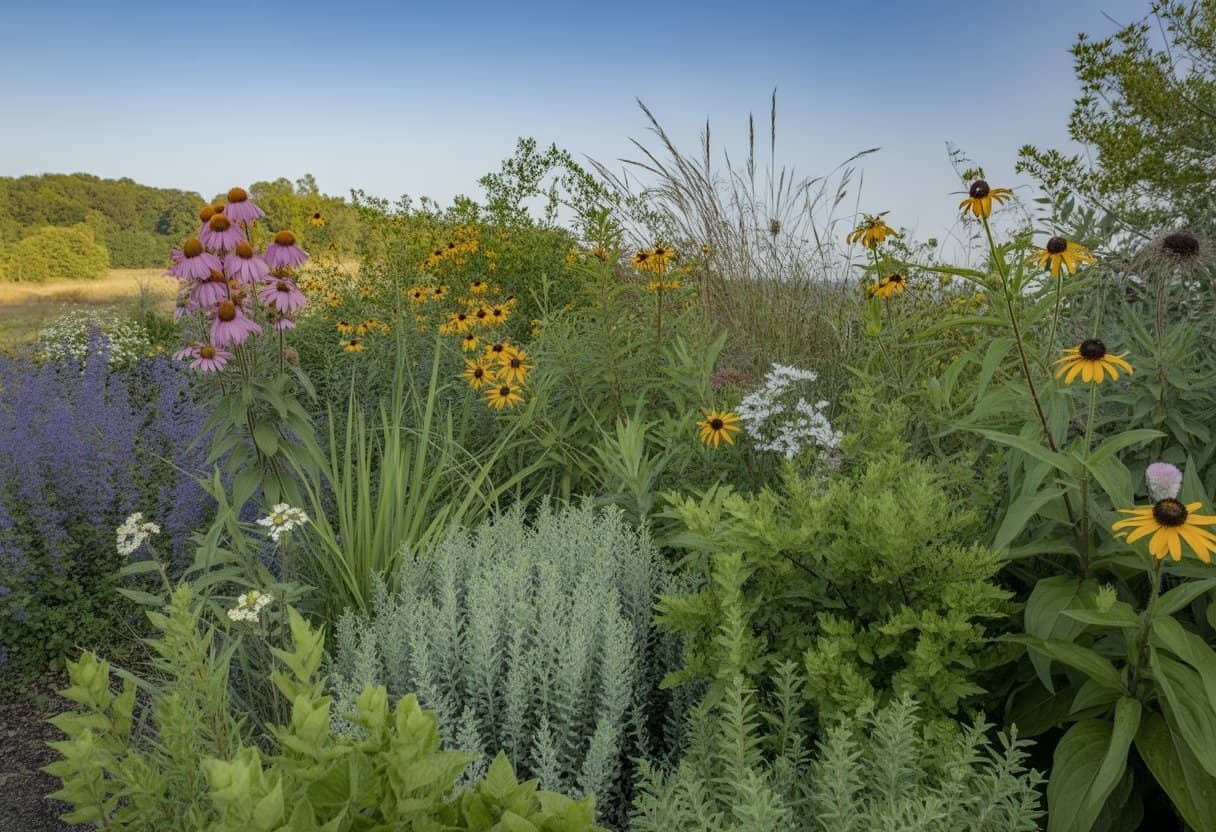
Native plants offer many advantages for Delaware gardeners and the local ecosystem. These plants have adapted to the region’s climate and soil, making them resilient choices that provide ecological benefits.
Supporting Pollinators and Native Insects
Delaware’s native plants play a crucial role in supporting local pollinators like bees, butterflies, and hummingbirds. These species have evolved alongside native plants, creating important relationships for reproduction and survival.
Research shows that native plants support pollinators better than non-native alternatives. The cardinal flower, New England aster, and butterfly weed attract many pollinators in Delaware gardens.
Native insects also depend on specific native plants for food and shelter. For example, the monarch butterfly relies on milkweed to lay eggs and feed caterpillars.
Without these native plant connections, many insect populations would decline. Many Delaware gardeners notice more pollinator activity within one season after adding native plants.
Enhancing Wildlife Habitat
Native plants create vital habitats for Delaware wildlife. They offer food, shelter, and nesting sites that non-native plants often cannot provide.
Key Wildlife Benefits:
- Food sources: Native berries, nuts, and seeds feed local birds and mammals
- Shelter: Dense shrubs like inkberry holly provide protective cover
- Nesting materials: Grasses and plant fibers support bird nesting
Delaware’s native oak trees support over 500 species of caterpillars, which become essential food for birds raising their young. In comparison, non-native ginkgo trees support only 5 caterpillar species.
Birds like the eastern bluebird depend on native plant habitats. These birds help control insect populations naturally, reducing the need for chemical pesticides.
Promoting Conservation
Growing native plants helps conserve Delaware’s natural heritage and unique ecosystems. Many native plant species face threats from development, invasive species, and climate change.
Home gardens with native plants serve as “stepping stones” between larger natural areas, helping wildlife move safely across fragmented landscapes. This connectivity is essential for genetic diversity and species survival.
Native plants usually need less water once established, reducing irrigation needs by up to 80% compared to conventional landscapes. Water conservation is increasingly important as Delaware faces more frequent droughts.
By choosing natives like black-eyed Susans instead of imported ornamentals, gardeners help preserve Delaware’s botanical diversity. These conservation efforts strengthen entire ecosystems.
Popular Delaware Native Flowers
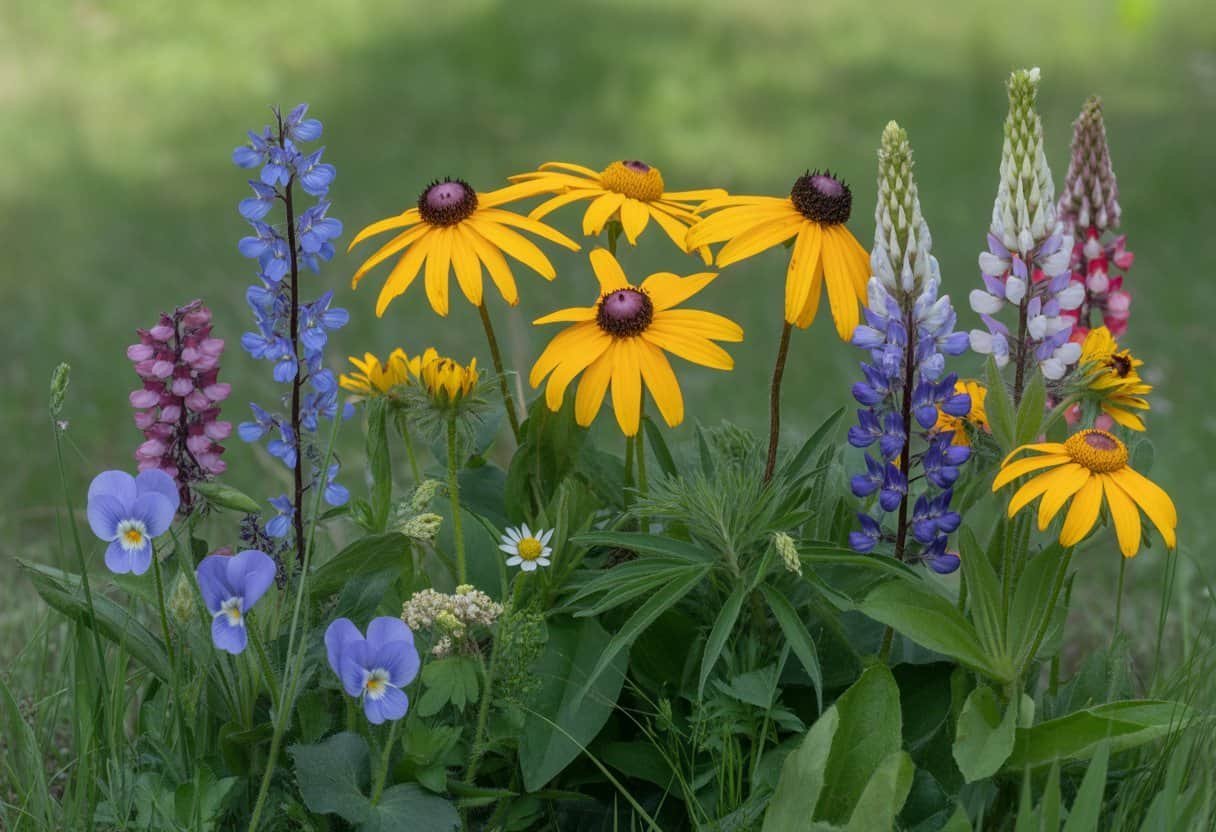
Delaware’s native flowers bring beauty to gardens while supporting local wildlife. These blooms have adapted to the state’s climate and soil, making them low-maintenance options for home landscapes.
Butterfly Milkweed and Its Benefits
Butterfly milkweed (Asclepias tuberosa) stands out with its bright orange flowers that bloom from June to August. This drought-tolerant perennial grows 1-3 feet tall and thrives in full sun and well-drained soil.
The plant serves as the essential host for monarch butterfly caterpillars. Without milkweed, monarchs cannot complete their life cycle.
Butterfly milkweed also attracts bees and hummingbirds. Its deep taproots make it resilient during dry periods once established.
Gardeners appreciate that this plant requires little maintenance. It resists deer and rabbits due to its milky sap.
For best results, plant butterfly milkweed in groups of three or more to create an eye-catching display.
Black-Eyed Susan for Bright Blooms
Black-Eyed Susan (Rudbeckia hirta) delivers golden-yellow flowers with dark centers from June through October. This hardy biennial or short-lived perennial reaches 1-3 feet tall.
These sun-loving plants adapt to various soil conditions, making them perfect for beginners. They spread naturally through self-seeding, creating drifts of color over time.
Black-Eyed Susans attract many beneficial insects including:
- Bees
- Butterflies
- Hoverflies
Birds, especially goldfinches, feast on their seeds during fall and winter. These flowers make excellent cutting flowers that last up to 10 days in arrangements.
For continuous blooms, deadhead spent flowers regularly. Black-Eyed Susans combine well with purple coneflowers and ornamental grasses.
New England Aster for Late-Season Color
New England Aster (Symphyotrichum novae-angliae) provides late-season color with its purple, pink, or blue daisy-like flowers from August through October. This perennial grows 3-6 feet tall and 2-3 feet wide.
The plant serves as a vital food source for bees and butterflies preparing for migration or winter. Monarch butterflies visit these flowers during their fall migration.
New England Aster thrives in full to partial sun and moderately moist soil. For bushier growth and more flowers, pinch stems back by one-third in early summer.
To prevent flopping, plant asters among sturdy companions or in sheltered locations. The plant’s height makes it perfect for the middle or back of garden borders.
Cardinal Flower for Pollinator Gardens
Cardinal Flower (Lobelia cardinalis) produces spikes of brilliant red blooms from July through September. This perennial reaches 2-4 feet tall and prefers moist conditions.
The tubular flowers are shaped for hummingbird beaks, making it one of the best native plants for attracting these birds. Ruby-throated hummingbirds especially favor this plant.
Cardinal Flower grows best in locations with morning sun and afternoon shade. It tolerates wet soil and even thrives along pond edges or in rain gardens.
The plant spreads gradually through self-seeding and offsets. For maximum impact, plant in groups of five or more.
Cardinal Flower pairs well with blue lobelia and joe-pye weed in moist garden areas.
Ornamental and Perennial Native Plants
Delaware’s native plants offer beautiful options for gardens that thrive year after year without extensive care. These plants support local wildlife while providing visual interest through different seasons.
Wild Bergamot for Fragrance
Wild bergamot (Monarda fistulosa) is one of Delaware’s most aromatic native plants. This member of the mint family grows 2-4 feet tall and produces lavender-purple flowers from July through September.
Bees, butterflies, and hummingbirds visit wild bergamot for its sweet nectar. The plant’s leaves release a spicy, oregano-like scent when crushed.
Wild bergamot adapts well to various soil conditions and thrives in full sun to partial shade. It spreads gradually through underground stems, creating natural clusters over time.
For best results, plant wild bergamot in well-draining soil and space plants 18-24 inches apart. The dried leaves can be used to make herbal tea.
Purple Coneflower for Vibrant Displays
Purple coneflower (Echinacea purpurea) brings reliable summer color to Delaware gardens. This perennial produces flowers with drooping pink-purple petals surrounding a spiky orange-brown center cone.
Growing 2-5 feet tall, purple coneflower blooms from June through August. It attracts pollinators, including butterflies, bees, and birds that feed on its seeds in fall and winter.
Purple coneflower’s drought tolerance makes it perfect for low-maintenance gardens. It performs best in full sun but tolerates light shade.
Benefits of Purple Coneflower:
- Long blooming period (8-10 weeks)
- Deer resistant
- Drought tolerant once established
- Provides winter interest with seed heads
- Self-seeds naturally
Cut spent flowers to encourage more blooms and prevent excessive self-seeding if desired.
Plants for Fall Color
Delaware native plants offer spectacular autumn displays long after summer blooms fade. Black-eyed Susan (Rudbeckia hirta) extends color into fall with golden-yellow flowers that contrast beautifully with purple asters.
Sweet goldenrod (Solidago odora) produces bright yellow flower plumes in September and October. It has a pleasant anise scent and a compact growth habit, reaching 2-3 feet tall.
Red maple (Acer rubrum) transforms landscapes with brilliant scarlet foliage. These trees thrive in Delaware’s climate and soil conditions and provide shade in summer.
Virginia sweetspire (Itea virginica) stands out for its garnet-red fall color. This compact shrub (3-5 feet) grows well in both sunny and partially shaded locations, making it versatile for many garden settings.
Combine these natives with native grasses like little bluestem for reliable fall interest. Little bluestem turns a striking copper-orange as temperatures cool.
Native Trees of Delaware
Delaware forests showcase a rich variety of native tree species that have adapted to the state’s diverse soils and climate. These native trees provide essential wildlife habitat and contribute to Delaware’s natural heritage.
American Holly as an Iconic Native
American holly (Ilex opaca) is Delaware’s official state tree. Its spiny, evergreen leaves and bright red berries make it easy to recognize.
This tree grows naturally throughout the state, especially in moist woodlands and sandy coastal areas. American holly trees can reach 40-50 feet tall in favorable conditions.
They often live 100-150 years in the wild. Female trees produce the distinctive red berries that persist through winter and provide vital food for birds and small mammals.
Male trees do not produce berries but are necessary for pollination. Native Americans once used holly wood for tools and the berries for decoration.
Oak Trees and Their Ecological Role
Several oak species dominate Delaware’s forests, including white oak, red oak, and black oak. These majestic trees form the backbone of many woodland ecosystems across the state.
Oak trees produce acorns that feed over 100 wildlife species, including deer, squirrels, and turkeys. A single mature oak can produce thousands of acorns in a good year.
Key Delaware Oak Species:
- White Oak (Quercus alba): Lives 300+ years, prefers well-drained upland soils
- Northern Red Oak (Quercus rubra): Fast-growing, adapts to various conditions
- Pin Oak (Quercus palustris): Thrives in wet areas, distinctive drooping lower branches
Oaks support countless insect species, especially moth and butterfly caterpillars. These insects become food for birds and help create a complex food web.
American Beech and Its Unique Features
American beech (Fagus grandifolia) trees are easily identified by their smooth, light gray bark and oval leaves with toothed edges. These trees prefer rich, moist soils and are common in mature Delaware forests.
Beech trees can reach heights of 50-80 feet and spread their branches wide, creating dense shade. Their smooth bark makes them vulnerable to carving, which can cause damage and introduce disease.
The distinctive triangular nuts produced by beech trees provide important food for wildlife. Squirrels, chipmunks, and blue jays depend on these nutritious nuts.
Beech trees often hold onto dead leaves through winter. This trait, called marcescence, helps identify young beech trees even during dormant seasons.
Flowering Native Trees and Shrubs
Delaware gardens come alive with beautiful native flowering trees and shrubs. These woody plants provide stunning blooms and support local wildlife.
Eastern Redbud for Spring Interest
Eastern redbud (Cercis canadensis) delivers a spectacular spring display with bright pink-purple flowers that bloom directly on branches before leaves appear. This small native tree reaches 20-30 feet tall and thrives in both full sun and partial shade.
Redbuds prefer well-drained soil and establish quickly in Delaware gardens. Their heart-shaped leaves emerge with a reddish tint before turning green and then yellow in fall.
The flowers provide early-season nectar for pollinators, especially native bees. After flowering, the tree produces flat seed pods that persist into winter.
Plant redbuds as understory trees near larger shade trees or as focal points in smaller gardens. They require minimal maintenance once established.
Flowering Dogwood for Year-Round Beauty
Flowering dogwood (Cornus florida) is one of Delaware’s most beloved native trees. Its white or pink “flowers” (actually modified leaves called bracts) create a stunning spring display.
This medium-sized tree reaches 15-25 feet tall and performs best in partial shade with protection from afternoon sun. Dogwoods prefer moist, acidic soil with good drainage.
Summer brings glossy green leaves, followed by brilliant red-purple fall color. Bright red berries appear in autumn, providing food for birds and visual interest.
Birds nest in their branches and eat the berries, while several butterfly species use dogwoods as host plants for their larvae. Choose disease-resistant cultivars for healthier trees.
Plant dogwoods where they’ll receive morning sun but afternoon shade for best performance.
Establishing and Maintaining Native Plant Gardens
Creating a native plant garden in Delaware starts with understanding local growing conditions and choosing appropriate plants. The right soil, proper watering, and thoughtful design help your native plants thrive with minimal maintenance.
Understanding Soil Composition
Delaware soils vary significantly across the state. The northern regions have clay-loam soils, while southern Delaware features sandier soils.
Test your soil’s pH and nutrient levels with an inexpensive kit from a local garden center before planting. Most Delaware native plants prefer slightly acidic to neutral soil (pH 5.5-7.0).
Adding compost improves nearly all soil types by enhancing drainage in clay soils and increasing water retention in sandy soils. Different plants have different soil needs.
For example:
- Woodland natives like Wild Geranium thrive in rich, humus-filled soil.
- Meadow plants such as Black-eyed Susan adapt to average soils.
- Coastal species tolerate sandy, sometimes salty conditions.
Avoid excessive fertilization. Most native plants evolved in lean soils and do not need high nutrient levels.
Water Requirements for Native Species
Delaware native plants usually need less supplemental water than non-native ornamentals once established. New plantings need regular watering for the first growing season, usually 1-2 inches weekly.
During droughts, water newly planted specimens first. Established natives (2+ years old) generally survive dry periods without extra water.
Their deep root systems help them access water unavailable to shallow-rooted plants. Group plants with similar water needs together—a practice called hydrozoning.
For example:
- Low water use: Wild Indigo, Butterfly Weed, Little Bluestem
- Moderate water use: Cardinal Flower, New England Aster
- Higher water use: Swamp Milkweed, Joe-Pye Weed
Water in the morning to reduce evaporation and prevent fungal diseases. Soaker hoses or drip irrigation deliver water efficiently to roots.
Designing Rain Gardens
Rain gardens are shallow depressions planted with native species that capture and filter stormwater runoff. They work well in Delaware’s climate, which receives about 45 inches of rainfall annually.
Locate a rain garden at least 10 feet from building foundations, in a natural low spot that receives runoff. Size your rain garden to about 20-30% of the drainage area.
Create three planting zones based on moisture:
- Center (wettest): Blue Flag Iris, Swamp Milkweed
- Middle zone: New York Ironweed, Cardinal Flower
- Outer edge (driest): Black-eyed Susan, Switchgrass
Dig the depression 4-8 inches deep with gently sloping sides. Add compost to improve drainage, especially in clay soils.
A layer of mulch helps suppress weeds and retain moisture while plants establish. Rain gardens reduce flooding, recharge groundwater, and provide habitat for beneficial insects and birds.
Where to Buy Delaware Native Plants
Finding native plants in Delaware has become easier as more nurseries recognize the demand for local species. These specialized retailers offer a wide selection of trees, shrubs, wildflowers, and grasses native to the region.
Finding Local Nurseries
Several nurseries across Delaware specialize in native plants. Gateway Garden Center in Hockessin offers a diverse selection of Delaware natives, including wildflowers and shrubs adapted to local conditions.
East Coast Garden Center in Millsboro maintains a dedicated native plant section with knowledgeable staff who can help you select species for your specific conditions.
Delaware Nature Society’s Native Plant Sale happens each spring and fall at the Coverdale Farm Preserve. This event features hundreds of native species, with proceeds supporting conservation.
University of Delaware Botanic Gardens holds seasonal plant sales featuring natives propagated in their own facilities. Their staff can provide excellent guidance on plant selection and care.
For online options, consider Prairie Nursery and Prairie Moon Nursery, which ship Delaware-appropriate native plants to your door. Many local nurseries now also offer online ordering with pickup or delivery.
Frequently Asked Questions
Delaware gardeners often have questions about native plants and how to use them in their landscapes. These answers address common concerns about identification, selection, and the benefits of native Delaware flora.
What are some popular native plants suitable for landscaping in Delaware?
Delaware gardens thrive with native plants like Black-Eyed Susan (Rudbeckia hirta) and Purple Coneflower (Echinacea purpurea). These flowering perennials add vibrant colors and require little maintenance.
Eastern Redbud (Cercis canadensis) offers spectacular spring blooms and serves as an excellent small ornamental tree. Its heart-shaped leaves provide visual interest throughout the growing season.
Switchgrass (Panicum virgatum) works well as a structural element in landscapes, providing winter interest and habitat for wildlife. It tolerates various soil conditions found in Delaware.
How can one identify native plant species in Delaware?
Field guides for the Mid-Atlantic region are excellent references for identifying Delaware native plants. Many include detailed photographs, bloom times, and habitat information.
The Delaware Native Plant Society offers resources, plant lists, and identification workshops throughout the year. Their website features searchable databases of native species.
Look at leaf arrangement, flower structure, and growth habit to distinguish natives from non-native species. The Delaware Center for Horticulture provides identification help for uncertain specimens.
Which native flowers are prevalent in Delaware?
Wild Columbine (Aquilegia canadensis) displays red and yellow blooms in spring and attracts hummingbirds. It grows naturally in rocky or woodland areas.
New England Aster (Symphyotrichum novae-angliae) produces purple-blue flowers in late summer through fall. This native perennial supports pollinators when many other plants have finished blooming.
Butterfly Weed (Asclepias tuberosa) features bright orange flower clusters that attract monarch butterflies and other pollinators. This drought-tolerant plant thrives in Delaware’s sandy soils.
Can you list some native shrubs commonly found in Delaware?
Inkberry (Ilex glabra) serves as an excellent native alternative to non-native boxwood. This evergreen shrub produces small black berries that persist through winter.
Winterberry (Ilex verticillata) offers spectacular red berries in winter after its leaves drop. The berries provide essential food for birds during harsh winter months.
Sweet Pepperbush (Clethra alnifolia) produces fragrant white flower spikes in summer that attract many pollinators. This shrub grows well in both wet and average garden conditions.
What are the benefits of using native plants in Delaware landscapes?
Native plants need less water, fertilizer, and pesticides once established. Their adaptation to local conditions means lower maintenance for homeowners.
Wildlife habitat improves with native plantings. Local birds, butterflies, and beneficial insects rely on these plants for food and shelter.
Native plants help preserve Delaware’s natural heritage and ecosystem health. They maintain genetic diversity and support food webs that non-native plants cannot replicate.
Which edible plants originating from Delaware can be safely consumed?
Pawpaw (Asimina triloba) produces tropical-tasting fruits with custard-like flesh. This small native tree grows naturally in Delaware’s woodlands.
American Persimmon (Diospyros virginiana) bears sweet orange fruits after the first frost. The fruits become sweeter as they ripen, changing from astringent to edible.
Wild Blueberries (Vaccinium species) offer nutritious berries. These native shrubs prefer acidic soil conditions found in parts of Delaware.

